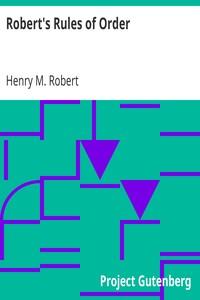Read this ebook for free! No credit card needed, absolutely nothing to pay.
Words: 35562 in 9 pages
This is an ebook sharing website. You can read the uploaded ebooks for free here. No credit cards needed, nothing to pay. If you want to own a digital copy of the ebook, or want to read offline with your favorite ebook-reader, then you can choose to buy and download the ebook.


: Robert's Rules of Order Pocket Manual of Rules of Order for Deliberative Assemblies by Robert Henry M Henry Martyn - Parliamentary practice Reference
Preface Introduction Parliamentary Law Plan of the Work Definitions
Legal Rights of Deliberative Assemblies Table of Rules Relating to Motions Index
INTRODUCTION.
Parliamentary Law.
Parliamentary Law refers originally to the customs and rules of conducting business in the English Parliament; and thence to the customs and rules of our own legislative assemblies. In England these customs and usages of Parliament form a part of the unwritten law of the land, and in our own legislative bodies they are of authority in all cases where they do not conflict with existing rules or precedents.
But as a people we have not the respect which the English have for customs and precedents, and are always ready for innovations which we think are improvements, and hence changes have been and are being constantly made in the written rules which our legislative bodies have found best to adopt. As each house adopts its own rules, it results that the two houses of the same legislature do not always agree in their practice; even in Congress the order of precedence of motions is not the same in both houses, and the Previous Question is admitted in the House of Representatives, but not in the Senate. As a consequence of this, the exact method of conducting business in any particular legislative body is to be obtained only from the Legislative Manual of that body.
The vast number of societies, political, literary, scientific, benevolent and religious, formed all over the land, though not legislative, are still deliberative in their character, and must have some system of conducting business, and some rules to govern their proceedings, and are necessarily subject to the common parliamentary law where it does not conflict with their own special rules. But as their knowledge of parliamentary law has been obtained from the usages in this country, rather than from the customs of Parliament, it has resulted that these societies have followed the customs of our own legislative bodies, and our people have thus been educated under a system of parliamentary law which is peculiar to this country, and yet so well established as to supersede the English parliamentary law as the common law of ordinary deliberative assemblies.
The practice of the National House of Representatives should have the same force in this country as the usages of the House of Commons have in England, in determining the general principles of the common parliamentary law of the land; but it does not follow that in every matter of detail the rules of Congress can be appealed to as the common law governing every deliberative assembly. In these matters of detail, the rules of each House of Congress are adapted to their own peculiar wants, and are of no force whatever in other assemblies.
But upon all great parliamentary questions, such as what motions can be made, what is their order of precedence, which can be debated, what is their effect, etc., the common law of the land is settled by the practice of the U. S. House of Representatives, and not by that of the English Parliament, the U. S. Senate, or any other body.
Plan of the Work.
The Manual is divided into two distinct parts, each complete in itself.
Part I contains a set of Rules of Order systematically arranged, as shown in the Table of Contents. Each one of the forty-five sections is complete in itself, so that no one unfamiliar with the work can be misled in examining any particular subject. Cross references are freely used to save repeating from other sections, and by this means the reader, without using the index, is referred to everything in the Rules of Order that has any bearing upon the subject he is investigating. The references are by sections, and for convenience the numbers of the sections are placed at the top of each page. The motions are arranged under the usual classes, in their order of rank, but in the index under the word motion will be found an alphabetical list of all the motions generally used. In reference to each motion there is stated:
Free books android app tbrJar TBR JAR Read Free books online gutenberg
More posts by @FreeBooks








